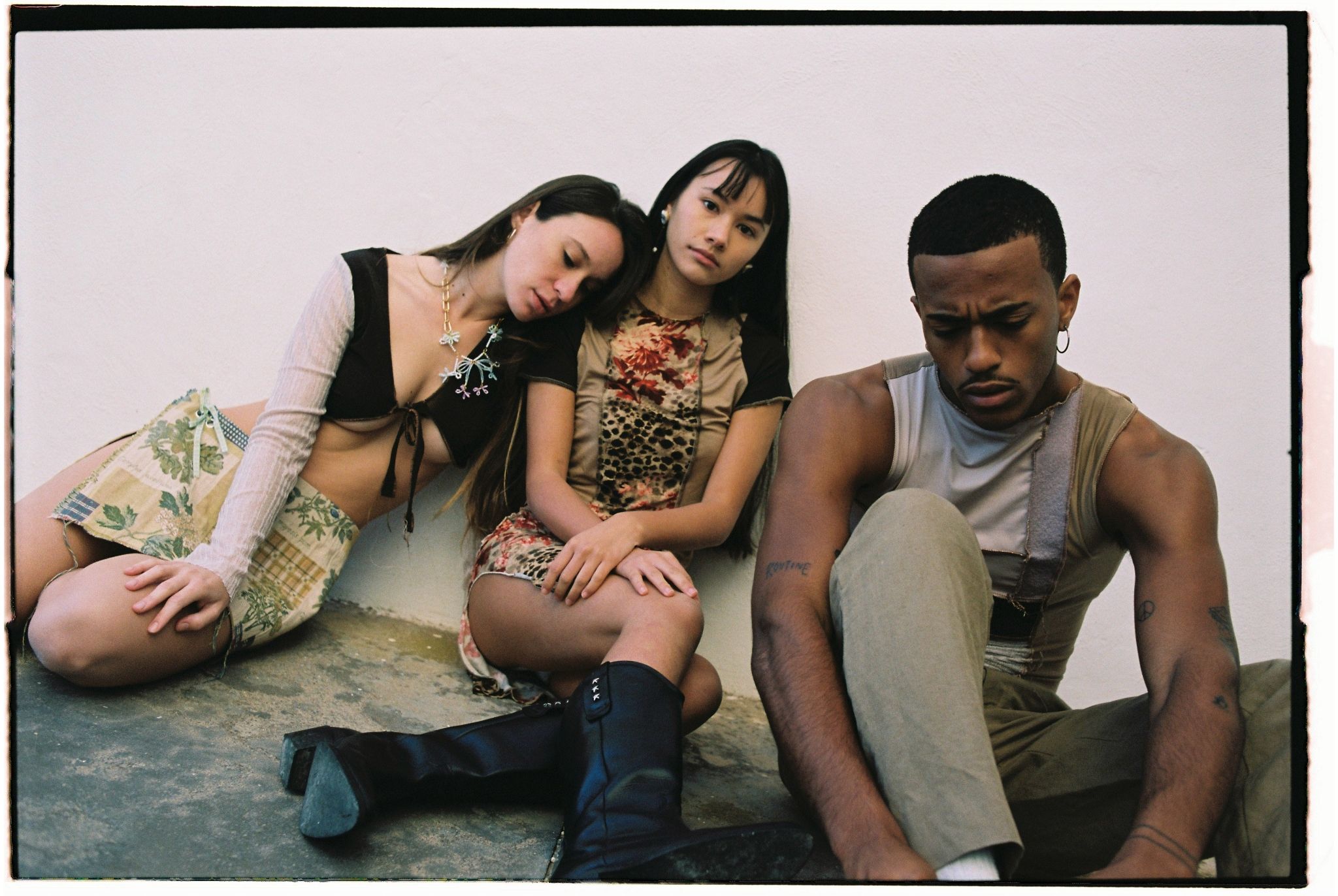
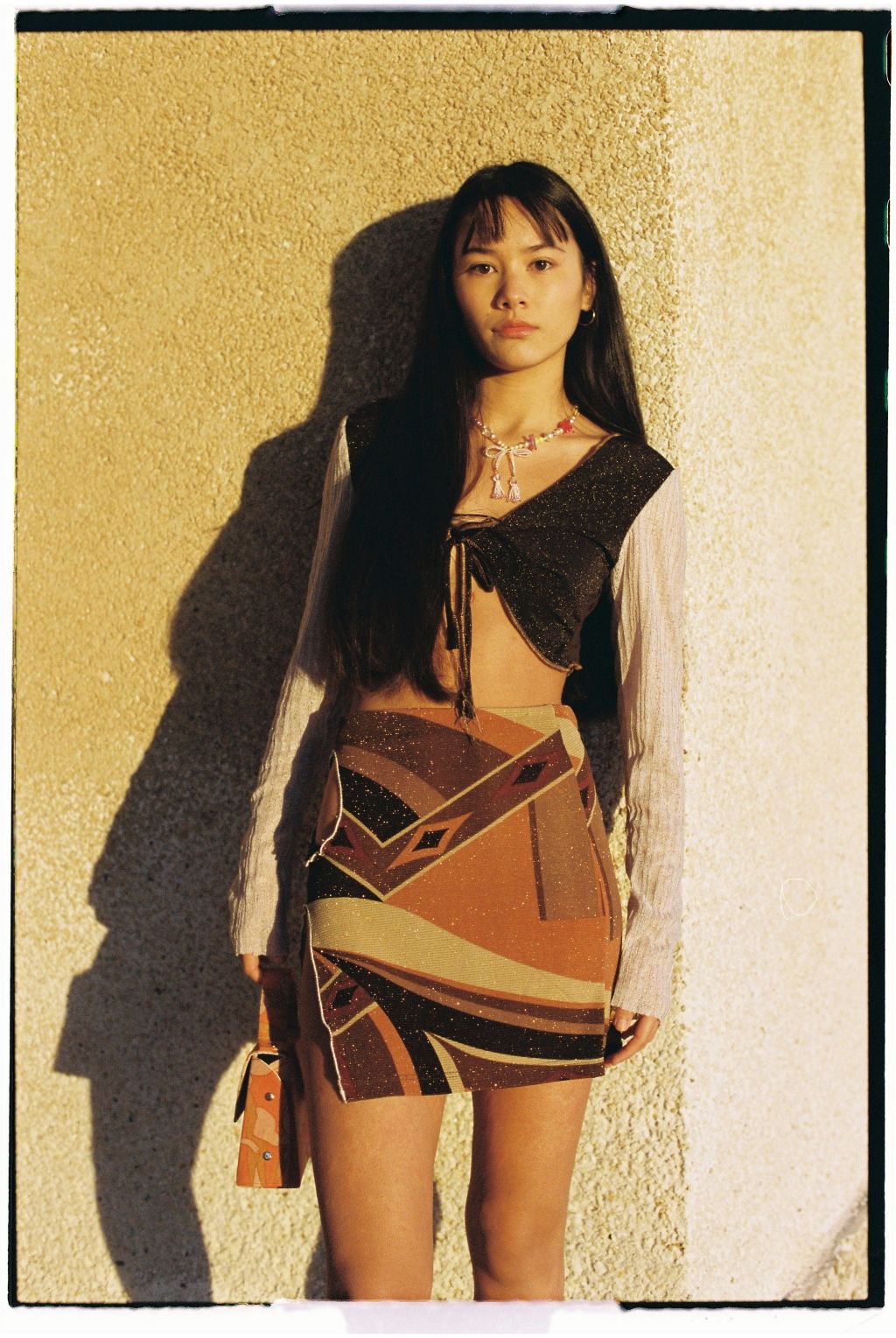
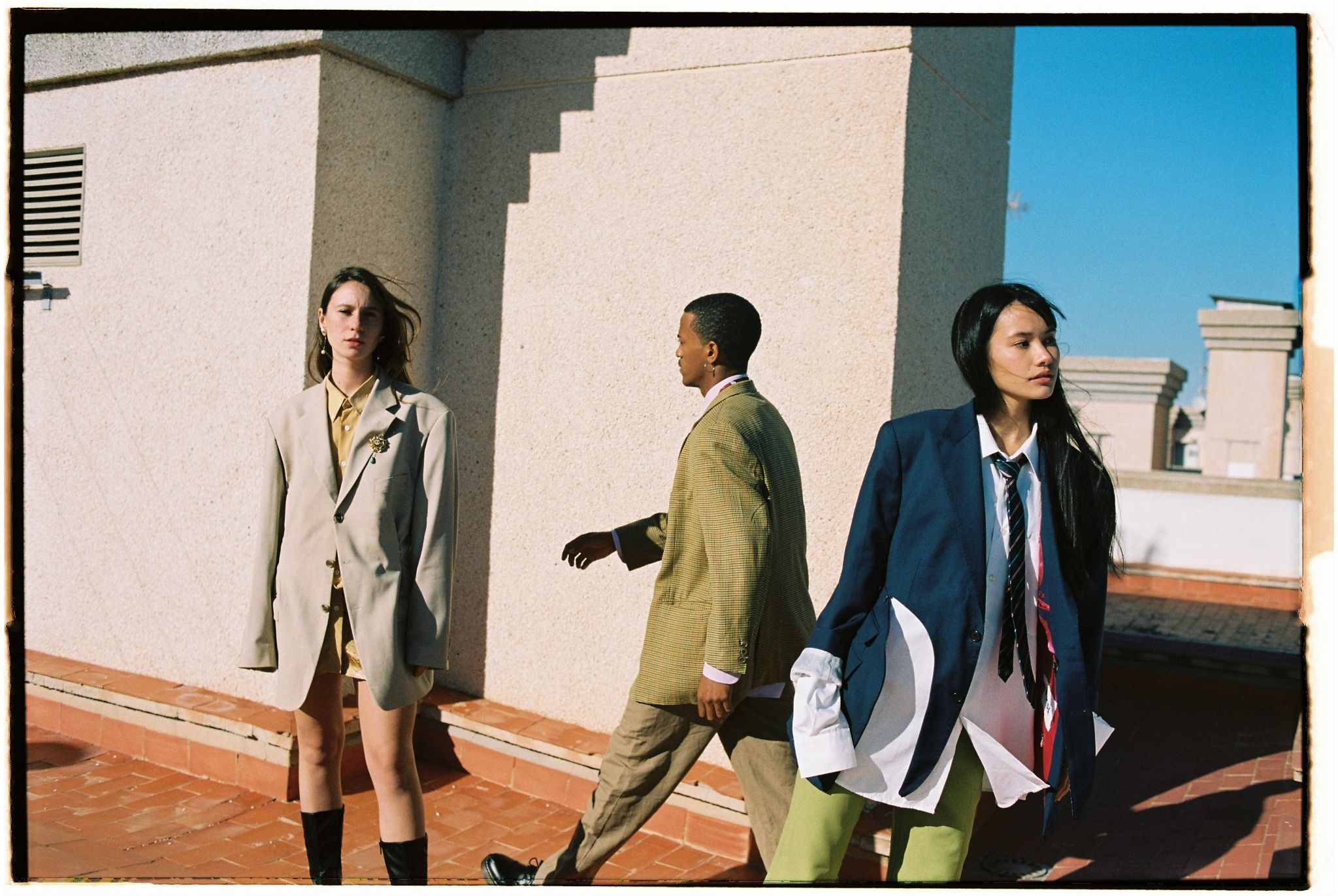
María Bernad unveils her universe of vintage and upcycling: Les Fleurs Studio
MARCH 1, 2021
WORDS JESÚS S FERRERA
Before starting a long conversation with María Bernad in which she presents me her project and reflects on the world of fashion, we inevitably touch on the subject of the pandemic. We can’t avoid the issue. And we come to an unanimous conclusion: how much we can't wait to fly and how beautiful the outbreak of "life" on all levels will be when this is over. We are both excited. While the new normal is cooking, at SICKY we wanted to stop for a moment to get to know María and her beautiful project that she has created out of the need to become a meeting place for people who think and execute like her in the world of fashion. Taking advantage of her exposure in social media and as a vintage and upcycling savvy, she wants to be a spokesperson for a community of people fighting to instill a change. However, she states that from the beginning, she has never neglected a fundamental subject of her project, the aesthetics.
Les Fleurs Studio is the continuation on a larger scale of a project that began a few years ago as Les Fleurs, a vintage and upcycling brand that María herself produced. Lockdown gave her the opportunity to reflect and rethink where she wanted to take her life and her professional projects. This is how Bernad realised that there were many people working like her and that her exposure and experience could be very helpful. She needed to be at the helm of what could be (and has actually been) a breakthrough.
And so, in the most organic way, and after the pertinent time of reflection, her confinement in Paris turned into a to-and-fro of calls, emails and thousands of procedures to launch last September Les Fleurs Studio. A market-place that brings together emerging designers and more established ones. All of them share a social conscience and want to be part of the comprehensive reform that the fashion industry needs. And just like that, she became the commandeer of (at the very least) a pivotal project.
Les Fleurs Studio transcends fashion to be present in various aspects of everyday life. In addition to clothing, they sell jewellery and household items. All under the same ethical and aesthetic foundations. In the end, it is a ubiquitous universe that María Bernad has created as a result of her work as a curator. It is undoubtedly a reflection of a personality that is not only creative, but also assertive, conscious and disruptive.

To start with, I would like you to present yourself to those who do not know you yet. What’s the label that better defines you?
For a long time I didn't like the influencer label. When I started with Instagram, I was studying fashion design. I remember that all of this came to me suddenly. I had never had Facebook or any other social network because I never liked personal exposure. I actually got Instagram because it was the only app that seemed creative to me. I could upload photos, and I love photography.
I was studying and I started posting fashion stuff. I would draw sketches of mannequins and put skirts with flowers on them. I started selling them on Instagram. And just like that, followers went up.
When I started Instagram I was into vintage, I had started my brand... I was doing a lot of things. I didn’t like that label “influencer” because I thought I was being labelled as something I was not. I’ve always been working on fashion, I don't sell my personal life and I don't consider mine to be an egocentric profile with only photos of myself. Finally, I ended up accepting it, “let them call me what they want”.
It's very difficult to put it all in one word, sometimes they call me a creative, it can be an easy term that would encompass a bit of everything. In the end I use my platforms as a tool to publish my work: I've been a stylist, I'm a designer for my brand and now I'm a curator. I am creating a universe through my online platforms.
I think the term curator is a good label for you. Your work at Les Fleurs Studio is a bit like what you’ve been doing with your Instagram account for years. On Instagram you decide what fashion content you show to your followers, and so you do in Les Fleurs Studio, selecting the products to create your own universe.
Yes, I am actually a buyer for a market-place, to name it someway. But I am also the creative director, so I decide any content that gets into the platform, whether designers, garments, visual content, collages... Everything goes through me first. I even carry Social Networks, I’ve been working for years in this world and I think there’s no-one better to reflect properly what Les Fleurs Studio is. Ultimately, what I do on Instagram is content curation, in Les Fleurs Studio I do the same but extrapolated to more things: product and designers selection, photography, management...
A few years ago you started your own upcycling and vintage brand, Les Fleurs. Now you have evolved to Les Fleurs Studio. You own brand is also included in the market-place?
Yes. In fact, at the beginning people thought it was just my brand. It’s true that I stopped it for 4 months because of the launching of the platform, it’s been quite a lot of work. But I keep designing and now that is all set up, I can work on launching the new collection, with which I’m really excited. It’s coming out very soon.
How did you decide to stop being the only one producing to become a meeting place for other designers and brands?
It all came up during the first quarantine. It gave me a lot of food for thought and I had several breakdowns. I asked myself, what am I doing? What is the reality of what I am doing? What is the value of it? What could I do?
I stopped to think about what I believed in. Since I was studying I got very involved in sustainability, I started upcycling without even knowing what it was... When I started my brand a lot of people that were doing similar work reached me out to show me their work. That’s why during lockdown I thought about it again. I realised that I have a lot of power on Instagram, and that I wasn't using it as I should, I wasn't supporting enough the things I believe in. That’s how I came up with the idea of bringing all the designers together in one platform.
But then I also had a problem, the issue of greenwashing. I needed to make a very important filter so that the brands I worked with that were truly sustainable would not be dumbed down by those doing greenwashing. That's why I'm very involved in all the phases of the project, so that we can avoid this.
In the end, it's about creating a community of people who also support each other. A place that welcomes vintage and upcycling garments, with a good curation, and with my vision always present. People who follow me do it because they like my vision, so why not transfer this into a shop?
And well, that's how it all happened. I started it on my own during lockdown: calls, web development, interviews, meeting everyone via Zoom... The truth is that it is a very nice project. Furthermore, all the brands I have approached have accepted to collaborate, they have trusted me. I hope we will soon be able to travel so I can meet all the designers, choose the clothes in person... I’m very excited about the future.
Besides clothing, you sell jewellery and household items. The platform go beyond clothing to get inside different aspects of every-day life, and a universe is created. Would that be your universe? I mean, would you wear this clothes, this jewellery and would you have this items in your house?
Yes, totally. Now we haven’t been able to develop more widely the house area. It is very difficult to find people working on upclycling on this kind of products, almost no-one is doing it.
We recently made a collage called "Les Fleurs Studio World" and "Les Fleurs Studio Home", and it's a bit of a vision of transferring the theme of upcycling and sustainability to all fields: having it at home, having it on clothes and on jewellery.
The ethic part of Les Fleurs Studio is quite obvious -sustainability, awareness...-, but, what about the aesthetics values?
One of the reasons why I created Les Fleurs Studio was the need to have a platform in which to find sustainable trends and fashion. In fact, I always try to do sets styled by Les Fleurs Studio, so people can see that you can wear upcycling with style. I wanted to give a fashion approach, my aesthetic vision is what it is and I can translate it into upcycling. For me it was essential to have an aesthetic intention behind the ethic part of the project.
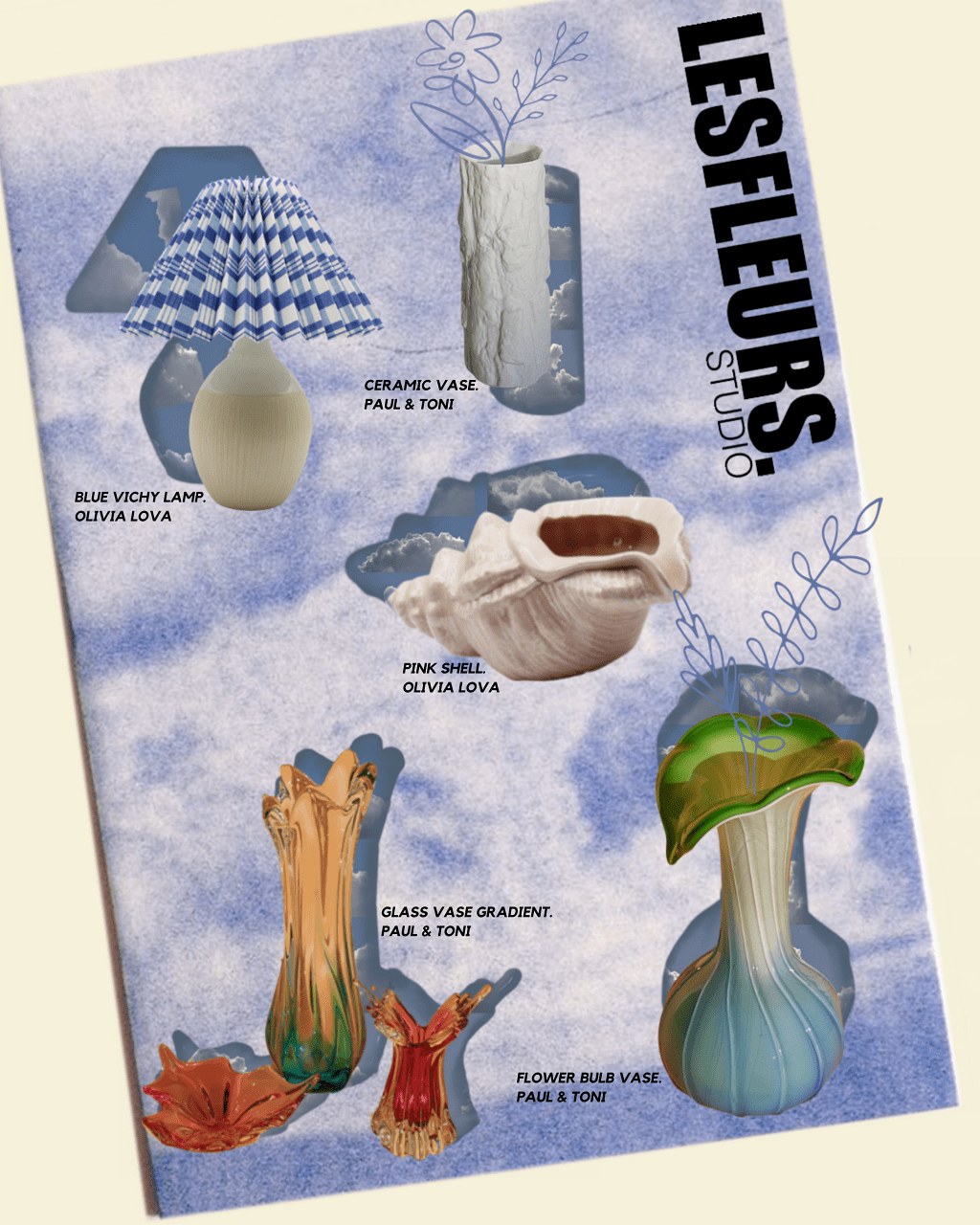

Tell me about you aesthetics sources of inspiration. Whether people, designers, artistic movements...
This one’s easy (laughs). When you study fashion design, the first thing they teach you is that you have to find inspiration from anything, even from a stone. Moreover, I’m very lucky because I’ve received a very good education. From a young age I’ve painted, read and I’ve been to a lot of museums in different cities around the world. Art inspires me a lot, colours, shapes… From abstract art to 17th century paintings. I have favorites: surrealism, impressionism...
But my greatest inspiration is cinema. Since I was very young I’ve seen a lot of films. I used to watch Agatha Christie films and Jane Birkin films -among others- with my mother. My background in cinema has always been very strong, and through cinema you see how fashion has evolved. It is a direct source of inspiration.
There are also designers who inspire me; a DIOR Haute Couture show by Galliano, a CHANEL show from the 2000s. The most important thing is that the designer needs to be an artist, and doesn’t have to be always looking to sell.
You said that designers need to be artists. Don’t you think we’ve lost a bit of that lately? Where has Galliano's theatricality gone?
Totally, I see old shows and I think “wow”, you can’t wear a piece. Like Galliano in 2003, with those queens with wigs and crowns... That’s fashion. At the end of the day, shows were created to do branding, not to sell garments. In fact, when I started with Les Fleurs I said, “I want to create, I want to be creative, I don’t care if I sell it or not” (laughs).
By the way, some years ago I presented a collection in Paris and I remember how people was freaking out. My inspirations has always been those. The show was a constant surrealism: people dressed 17ty century inspired mixed with present, very androgynous... The set was an art gallery from the 17th century, the whole thing was like a performance.
Tell me about Les Fleurs Studio’s Magazine.
I created the magazine because every month we launch a drop and we shoot with a photographer and several models. We usually interview the photographer and the models to know a bit about themselves. At the end of the day, I like the platform to be useful to promote creative’s work. We started with that, and now we’ve launched “Les Fleurs Studio Voices”, that are live interviews we make through Zoom. Also “Les Fleurs Studio Stories” is soon to be launched, in which we will interview artists from different disciplines, related to us, that feel part of the community. Eventually, we want to create interesting content that can be related to the platform itself and that can give a background to the people. In this way, we create a community of people with shared values.
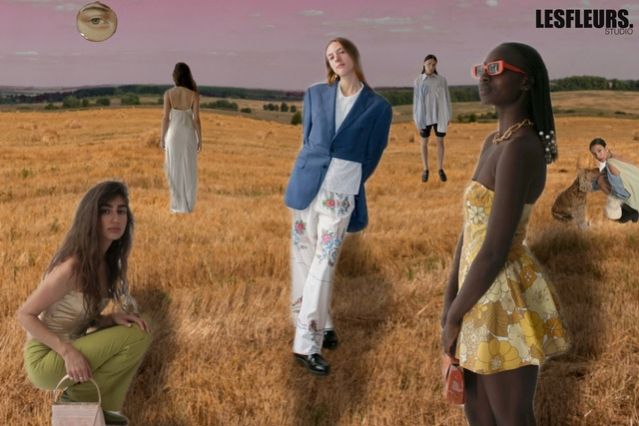
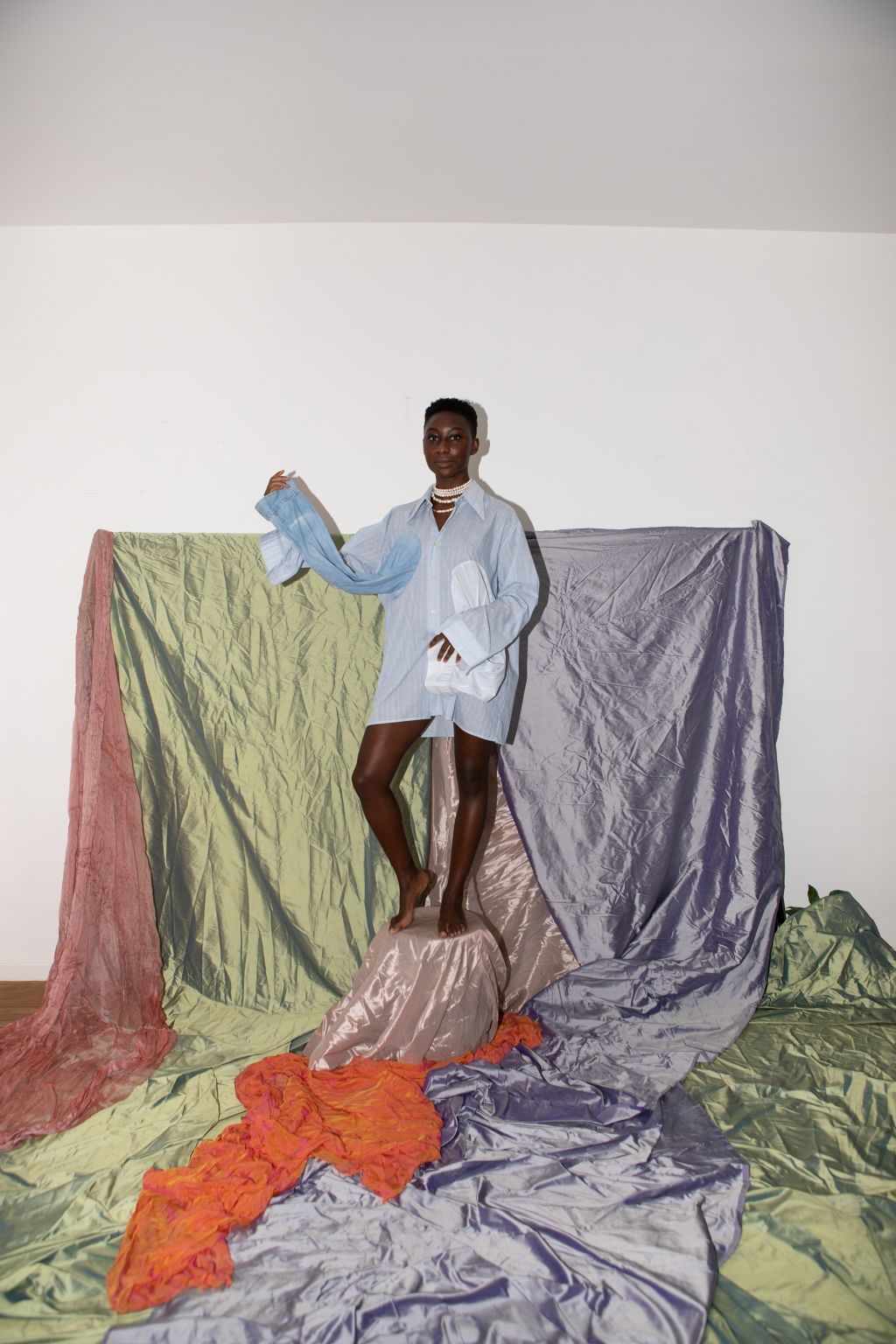
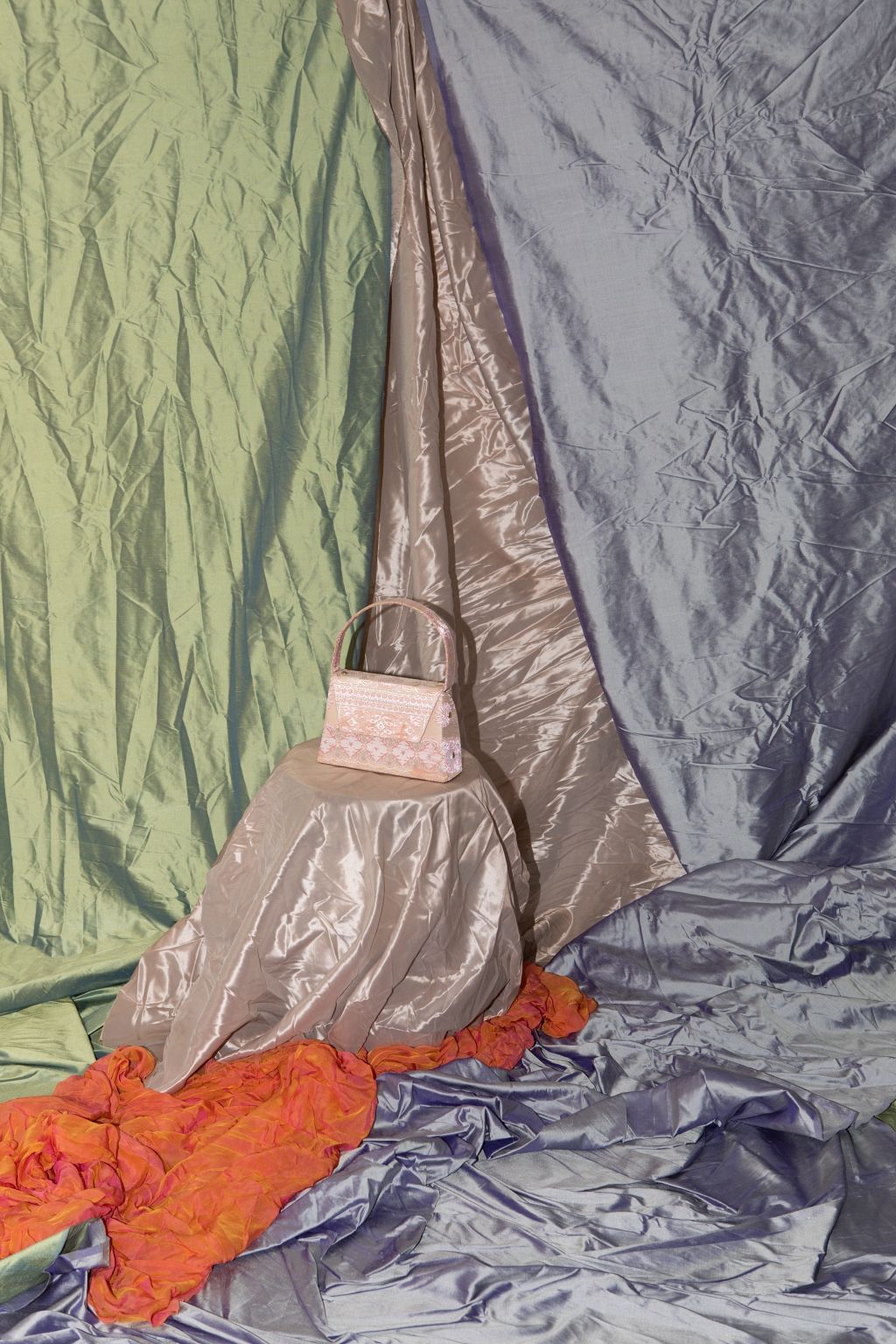
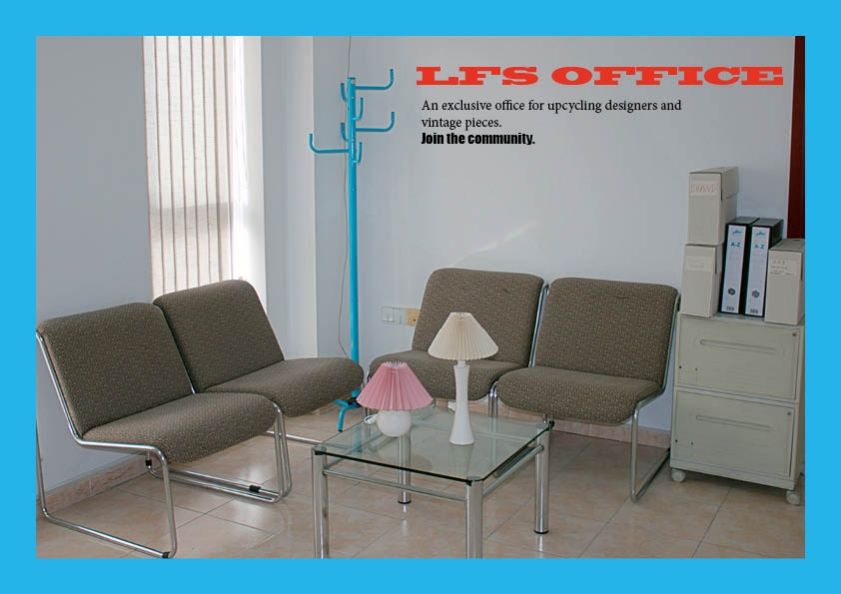
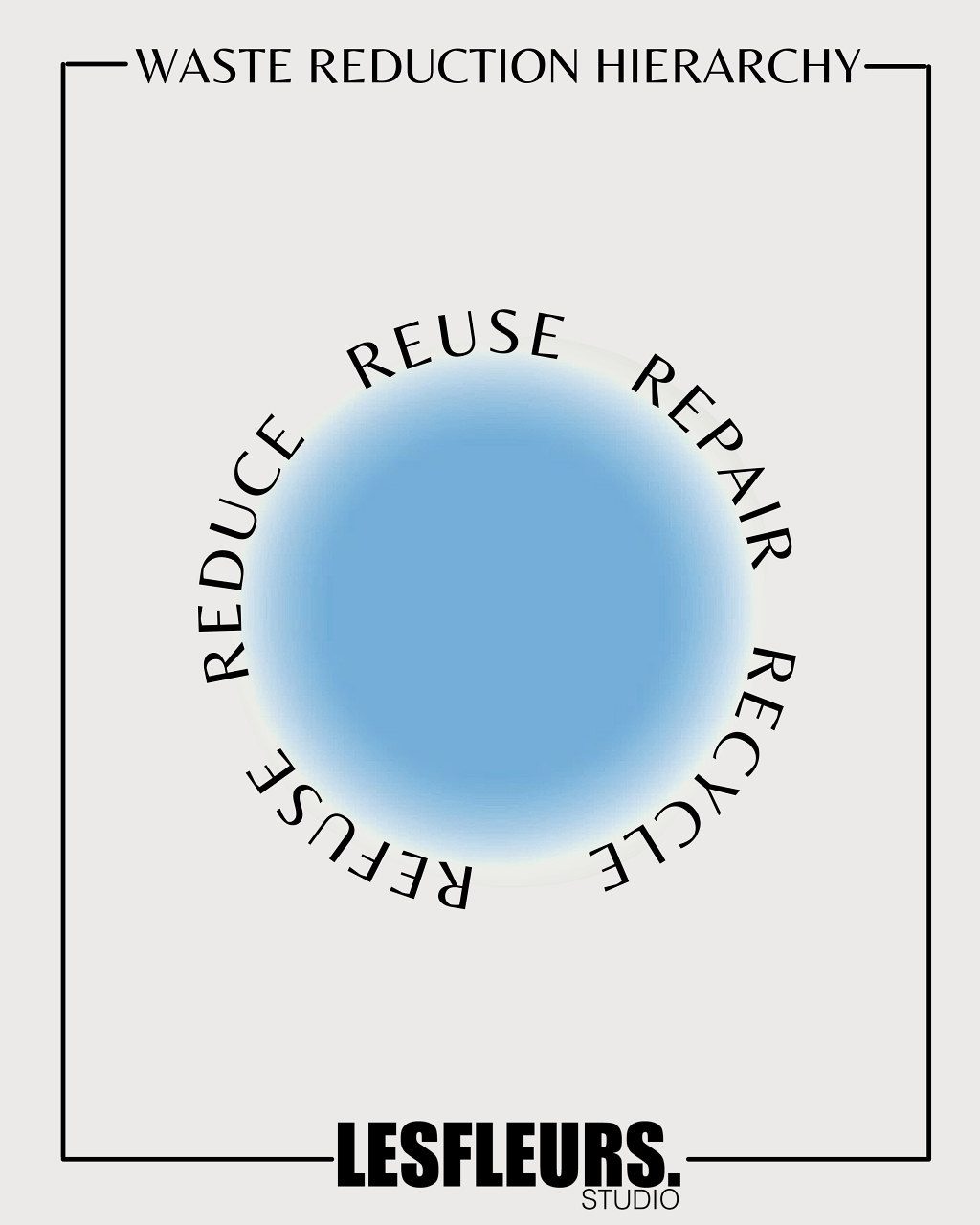
It is beautiful to create this whole thing. Fashion has a fundamental part but it is interesting that you open up to other things.
Yes, at the end of the day we’ve created a universe around who we are.
As a conclusion to this conversation, what would be your utopian fashion industry?
There used to be an specialisation that we’ve lost. In other words, there was a shop for each sector. For example, if you wanted shoes, you would go to the shoe shop; if you wanted a suit, you would go to the tailor's shop. People would buy the fabrics and then go to the dressmaker to have their dresses made. For me, a utopia would be to go back to specialisation. Not to go to an online shop that has absolutely everything. To go back to craftsmanship. The big companies have "killed off" these small artisans. And this is the only way to have a good product.
It is really important that people working in fashion respect and support this small business.
And finally, what are your plans for the future?
For me it would be idyllic to have a multidisciplinary physical space: a photography studio, a shop, a café... A place to share ideas. I don't know where I would have the physical space, probably in Paris or Copenhagen. Also, when the situation improves, I'd like to start traveling, meeting designers, selecting products first hand.



María Bernad unveils her universe of vintage and upcycling: Les Fleurs Studio
MARCH 1, 2021
WORDS JESÚS S FERRERA
Before starting a long conversation with María Bernad in which she presents me her project and reflects on the world of fashion, we inevitably touch on the subject of the pandemic. We can’t avoid the issue. And we come to an unanimous conclusion: how much we can't wait to fly and how beautiful the outbreak of "life" on all levels will be when this is over. We are both excited. While the new normal is cooking, at SICKY we wanted to stop for a moment to get to know María and her beautiful project that she has created out of the need to become a meeting place for people who think and execute like her in the world of fashion. Taking advantage of her exposure in social media and as a vintage and upcycling savvy, she wants to be a spokesperson for a community of people fighting to instill a change. However, she states that from the beginning, she has never neglected a fundamental subject of her project, the aesthetics.
Les Fleurs Studio is the continuation on a larger scale of a project that began a few years ago as Les Fleurs, a vintage and upcycling brand that María herself produced. Lockdown gave her the opportunity to reflect and rethink where she wanted to take her life and her professional projects. This is how Bernad realised that there were many people working like her and that her exposure and experience could be very helpful. She needed to be at the helm of what could be (and has actually been) a breakthrough.
And so, in the most organic way, and after the pertinent time of reflection, her confinement in Paris turned into a to-and-fro of calls, emails and thousands of procedures to launch last September Les Fleurs Studio. A market-place that brings together emerging designers and more established ones. All of them share a social conscience and want to be part of the comprehensive reform that the fashion industry needs. And just like that, she became the commandeer of (at the very least) a pivotal project.
Les Fleurs Studio transcends fashion to be present in various aspects of everyday life. In addition to clothing, they sell jewellery and household items. All under the same ethical and aesthetic foundations. In the end, it is a ubiquitous universe that María Bernad has created as a result of her work as a curator. It is undoubtedly a reflection of a personality that is not only creative, but also assertive, conscious and disruptive.

To start with, I would like you to present yourself to those who do not know you yet. What’s the label that better defines you?
For a long time I didn't like the influencer label. When I started with Instagram, I was studying fashion design. I remember that all of this came to me suddenly. I had never had Facebook or any other social network because I never liked personal exposure. I actually got Instagram because it was the only app that seemed creative to me. I could upload photos, and I love photography.
I was studying and I started posting fashion stuff. I would draw sketches of mannequins and put skirts with flowers on them. I started selling them on Instagram. And just like that, followers went up.
When I started Instagram I was into vintage, I had started my brand... I was doing a lot of things. I didn’t like that label “influencer” because I thought I was being labelled as something I was not. I’ve always been working on fashion, I don't sell my personal life and I don't consider mine to be an egocentric profile with only photos of myself. Finally, I ended up accepting it, “let them call me what they want”.
It's very difficult to put it all in one word, sometimes they call me a creative, it can be an easy term that would encompass a bit of everything. In the end I use my platforms as a tool to publish my work: I've been a stylist, I'm a designer for my brand and now I'm a curator. I am creating a universe through my online platforms.
I think the term curator is a good label for you. Your work at Les Fleurs Studio is a bit like what you’ve been doing with your Instagram account for years. On Instagram you decide what fashion content you show to your followers, and so you do in Les Fleurs Studio, selecting the products to create your own universe.
Yes, I am actually a buyer for a market-place, to name it someway. But I am also the creative director, so I decide any content that gets into the platform, whether designers, garments, visual content, collages... Everything goes through me first. I even carry Social Networks, I’ve been working for years in this world and I think there’s no-one better to reflect properly what Les Fleurs Studio is. Ultimately, what I do on Instagram is content curation, in Les Fleurs Studio I do the same but extrapolated to more things: product and designers selection, photography, management...
A few years ago you started your own upcycling and vintage brand, Les Fleurs. Now you have evolved to Les Fleurs Studio. You own brand is also included in the market-place?
Yes. In fact, at the beginning people thought it was just my brand. It’s true that I stopped it for 4 months because of the launching of the platform, it’s been quite a lot of work. But I keep designing and now that is all set up, I can work on launching the new collection, with which I’m really excited. It’s coming out very soon.
How did you decide to stop being the only one producing to become a meeting place for other designers and brands?
It all came up during the first quarantine. It gave me a lot of food for thought and I had several breakdowns. I asked myself, what am I doing? What is the reality of what I am doing? What is the value of it? What could I do?
I stopped to think about what I believed in. Since I was studying I got very involved in sustainability, I started upcycling without even knowing what it was... When I started my brand a lot of people that were doing similar work reached me out to show me their work. That’s why during lockdown I thought about it again. I realised that I have a lot of power on Instagram, and that I wasn't using it as I should, I wasn't supporting enough the things I believe in. That’s how I came up with the idea of bringing all the designers together in one platform.
But then I also had a problem, the issue of greenwashing. I needed to make a very important filter so that the brands I worked with that were truly sustainable would not be dumbed down by those doing greenwashing. That's why I'm very involved in all the phases of the project, so that we can avoid this.
In the end, it's about creating a community of people who also support each other. A place that welcomes vintage and upcycling garments, with a good curation, and with my vision always present. People who follow me do it because they like my vision, so why not transfer this into a shop?
And well, that's how it all happened. I started it on my own during lockdown: calls, web development, interviews, meeting everyone via Zoom... The truth is that it is a very nice project. Furthermore, all the brands I have approached have accepted to collaborate, they have trusted me. I hope we will soon be able to travel so I can meet all the designers, choose the clothes in person... I’m very excited about the future.


Besides clothing, you sell jewellery and household items. The platform go beyond clothing to get inside different aspects of every-day life, and a universe is created. Would that be your universe? I mean, would you wear this clothes, this jewellery and would you have this items in your house?
Yes, totally. Now we haven’t been able to develop more widely the house area. It is very difficult to find people working on upclycling on this kind of products, almost no-one is doing it.
We recently made a collage called "Les Fleurs Studio World" and "Les Fleurs Studio Home", and it's a bit of a vision of transferring the theme of upcycling and sustainability to all fields: having it at home, having it on clothes and on jewellery.
The ethic part of Les Fleurs Studio is quite obvious -sustainability, awareness...-, but, what about the aesthetics values?
One of the reasons why I created Les Fleurs Studio was the need to have a platform in which to find sustainable trends and fashion. In fact, I always try to do sets styled by Les Fleurs Studio, so people can see that you can wear upcycling with style. I wanted to give a fashion approach, my aesthetic vision is what it is and I can translate it into upcycling. For me it was essential to have an aesthetic intention behind the ethic part of the project.
Tell me about you aesthetics sources of inspiration. Whether people, designers, artistic movements...
This one’s easy (laughs). When you study fashion design, the first thing they teach you is that you have to find inspiration from anything, even from a stone. Moreover, I’m very lucky because I’ve received a very good education. From a young age I’ve painted, read and I’ve been to a lot of museums in different cities around the world. Art inspires me a lot, colours, shapes… From abstract art to 17th century paintings. I have favorites: surrealism, impressionism...
But my greatest inspiration is cinema. Since I was very young I’ve seen a lot of films. I used to watch Agatha Christie films and Jane Birkin films -among others- with my mother. My background in cinema has always been very strong, and through cinema you see how fashion has evolved. It is a direct source of inspiration.
There are also designers who inspire me; a DIOR Haute Couture show by Galliano, a CHANEL show from the 2000s. The most important thing is that the designer needs to be an artist, and doesn’t have to be always looking to sell.
You said that designers need to be artists. Don’t you think we’ve lost a bit of that lately? Where has Galliano's theatricality gone?
Totally, I see old shows and I think “wow”, you can’t wear a piece. Like Galliano in 2003, with those queens with wigs and crowns... That’s fashion. At the end of the day, shows were created to do branding, not to sell garments. In fact, when I started with Les Fleurs I said, “I want to create, I want to be creative, I don’t care if I sell it or not” (laughs).
By the way, some years ago I presented a collection in Paris and I remember how people was freaking out. My inspirations has always been those. The show was a constant surrealism: people dressed 17ty century inspired mixed with present, very androgynous... The set was an art gallery from the 17th century, the whole thing was like a performance.
Tell me about Les Fleurs Studio’s Magazine.
I created the magazine because every month we launch a drop and we shoot with a photographer and several models. We usually interview the photographer and the models to know a bit about themselves. At the end of the day, I like the platform to be useful to promote creative’s work. We started with that, and now we’ve launched “Les Fleurs Studio Voices”, that are live interviews we make through Zoom. Also “Les Fleurs Studio Stories” is soon to be launched, in which we will interview artists from different disciplines, related to us, that feel part of the community. Eventually, we want to create interesting content that can be related to the platform itself and that can give a background to the people. In this way, we create a community of people with shared values.





It is beautiful to create this whole thing. Fashion has a fundamental part but it is interesting that you open up to other things.
Yes, at the end of the day we’ve created a universe around who we are.
As a conclusion to this conversation, what would be your utopian fashion industry?
There used to be an specialisation that we’ve lost. In other words, there was a shop for each sector. For example, if you wanted shoes, you would go to the shoe shop; if you wanted a suit, you would go to the tailor's shop. People would buy the fabrics and then go to the dressmaker to have their dresses made. For me, a utopia would be to go back to specialisation. Not to go to an online shop that has absolutely everything. To go back to craftsmanship. The big companies have "killed off" these small artisans. And this is the only way to have a good product.
It is really important that people working in fashion respect and support this small business.
And finally, what are your plans for the future?
For me it would be idyllic to have a multidisciplinary physical space: a photography studio, a shop, a café... A place to share ideas. I don't know where I would have the physical space, probably in Paris or Copenhagen. Also, when the situation improves, I'd like to start traveling, meeting designers, selecting products first hand.